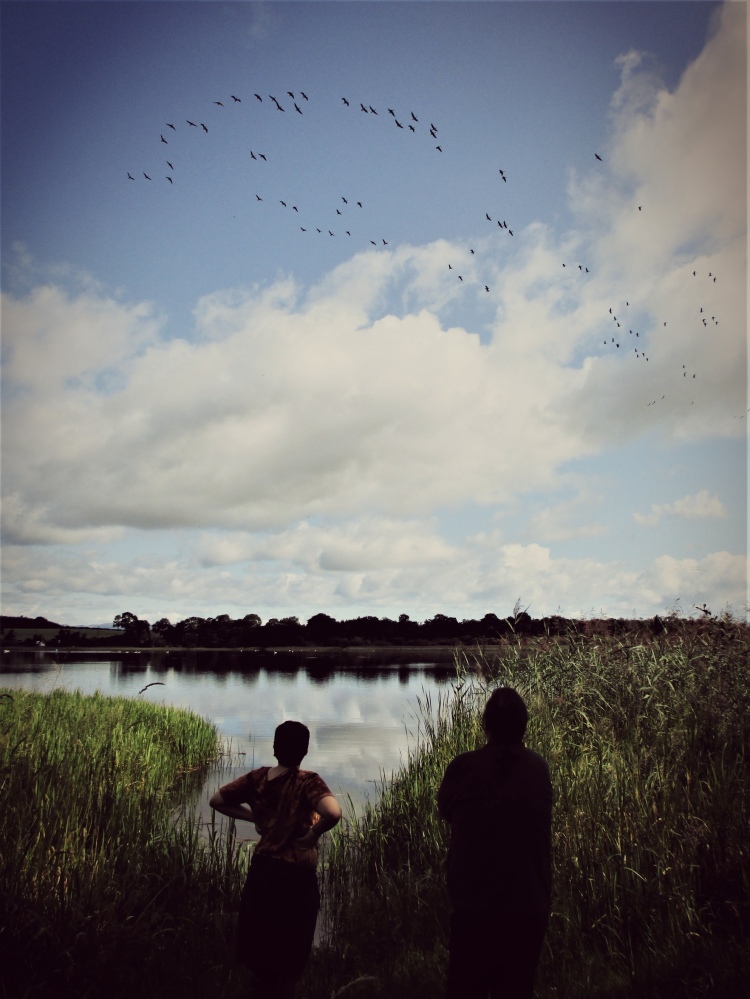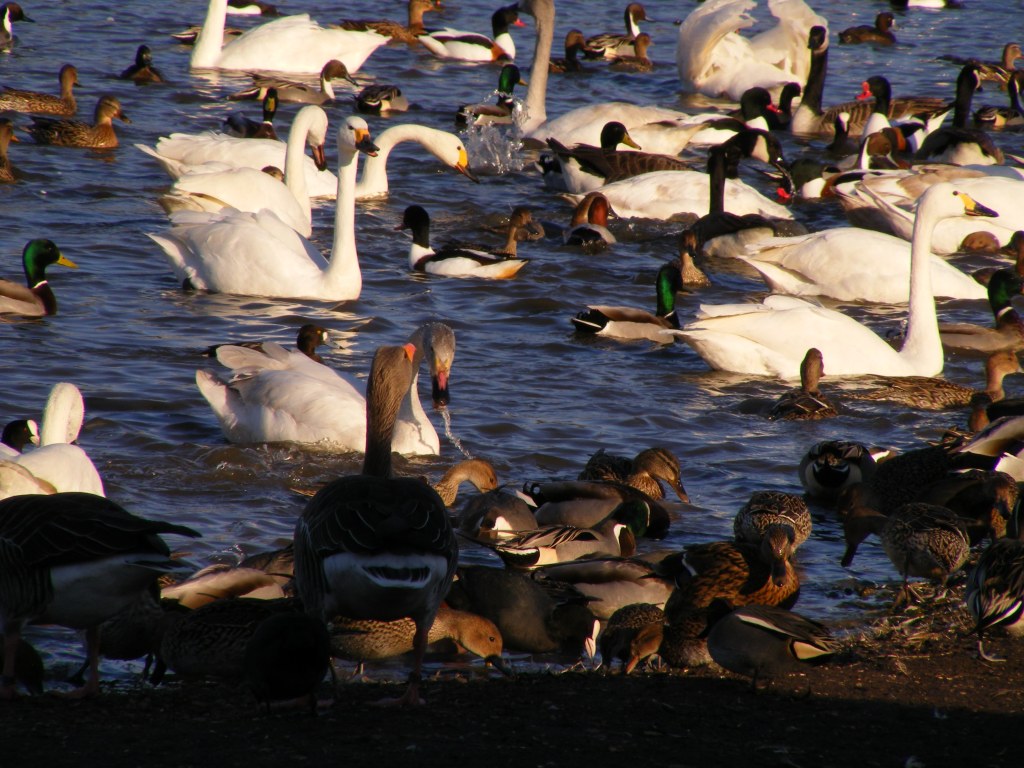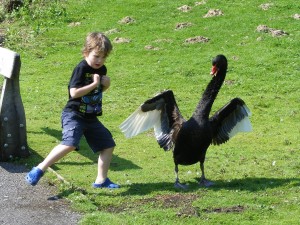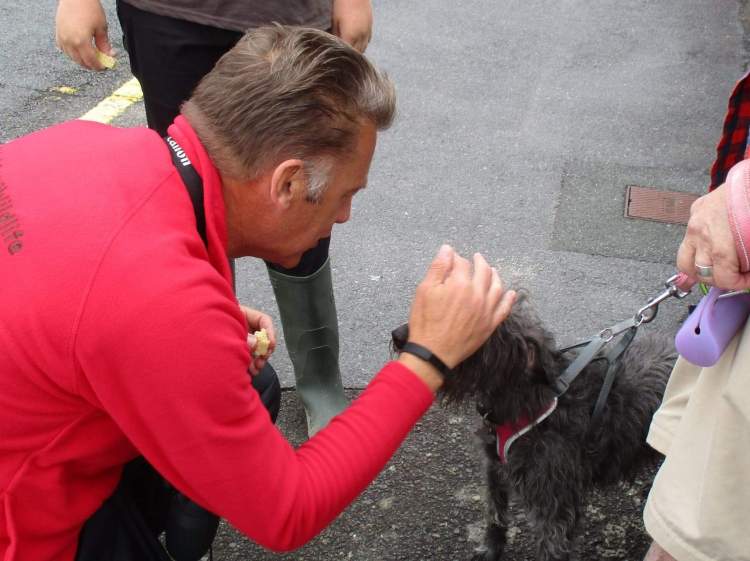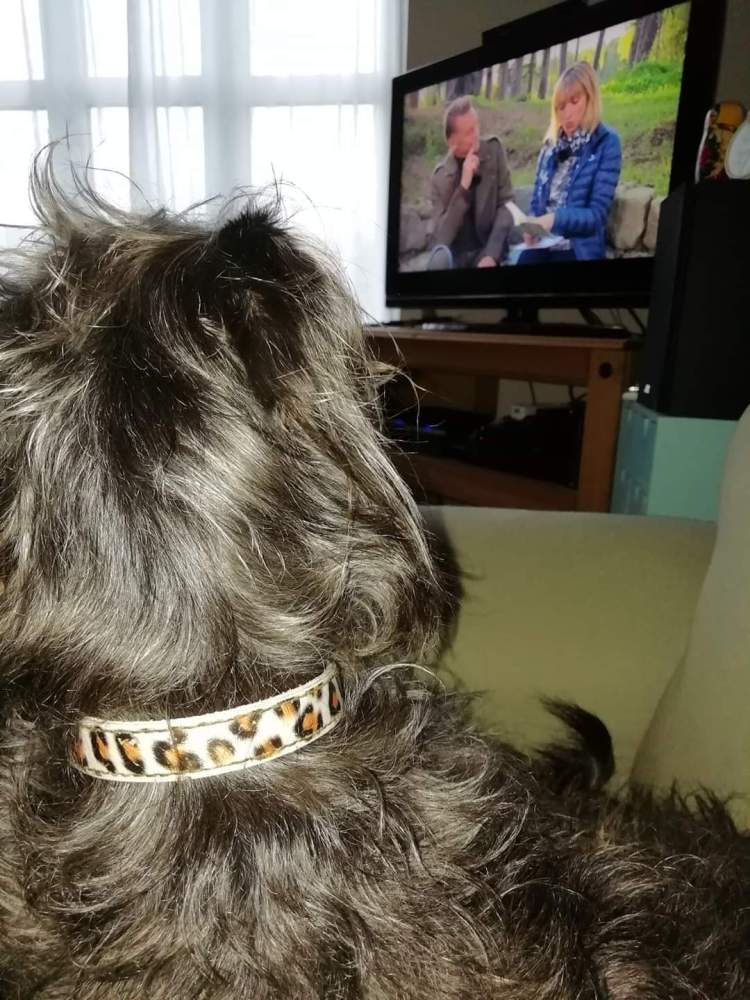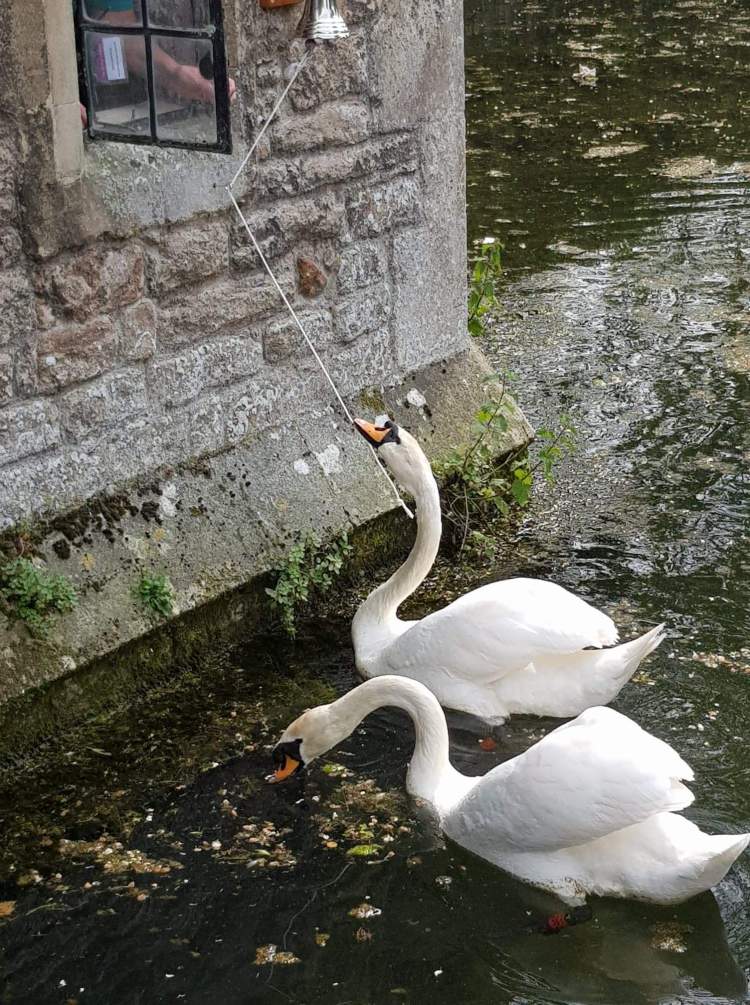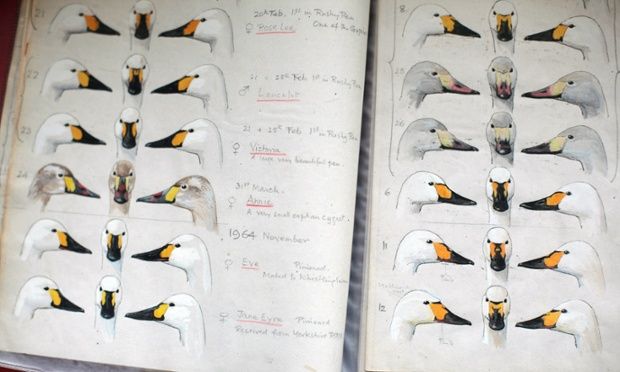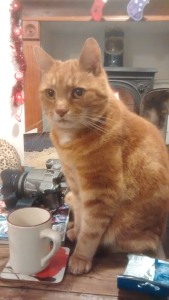

This morning, like most Sunday mornings, Blaze – my scruffy dog, and I took our walk around the village to check on what’s what. I get a great deal of satisfaction from seeing the ‘regulars’. The pair of magpies that look like they may nest in the tree next to the school; the drumming of the greater spotted woodpecker, noisily staking its territory in the woods by the bridge; the red kites busy re-establishing their pair bond ready to mate and hopefully raise chicks in last year’s nest.
This Sunday, the same as last week and the week before, a skein of loud, honking geese came flying overhead on their way – I expect, to the river by the castle to graze on the floodplain meadows and gather with all the other hundreds of geese that congregate there each day. I drive over the bridge by the river several times a week and I haven’t seen the huge flocks for a couple of days. I wonder if they’ve left for the summer to go back north to Scandinavia. My Sunday birds may be joining them or maybe they are like many of the Canada geese in the UK and resident here?
What tells them that it is time to migrate? Why even bother?
When we think about migration in animals and birds we are typically considering seasonal migration from north to south (or vice versa) as a reaction to resource availability. Food availability changes depending on seasonal fluctuations, and this influences migration patterns. Different species, like some fish, may migrate in order to reproduce. Cenarth Falls on the River Teifi is the first barrier the Salmon and Sewin have to leap whilst traveling upstream to mate before returning to the sea. It is a fantastic and picturesque spot for watching this incredible natural phenomenon. Temperature is also a driving factor of migration and many birds migrate to warmer locations during the winter to escape poor environmental conditions.
Migration isn’t the only solution to living on a planet that has changing seasons. Some animals stay put and hibernate like the hedgehog that uses our garden. I have had my trail camera out waiting for it to reappear and I expect it could come out of hibernation any time now. Other animals adapt to their environments – stoats living in very cold areas may turn white in winter and their ermine coats help them stay camouflaged in the snow. Jays and squirrels cache food for leaner times and foxes change their diet to take advantage of fruit and insects in the warmer months and rodents in the winter.
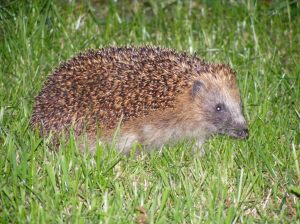
Migration can be obligate – where animals “must” migrate; or facultative, meaning they can “choose” to migrate or not. Not all animals in a species migrate – sometimes it is complete; sometimes it is partial; and sometimes it is differential, here the difference between migratory and non-migratory individuals is based on age or sex. While most migratory movements occur on an annual cycle, some daily movements are also referred to as migration. Think of the tide coming in and out each day, filling the rock pools and creating a food rich intertidal zone. Typically we think of migration taking place over large areas like the intercontinental migration of the Arctic Tern, or should that be the Antarctic Tern? Who is to say where its ‘home’ really is when it flies up to 50,000 miles each year! There are smaller migrations too and some animals like the earthworm don’t travel across the land or sea, but downwards into the deeper earth away from the cold frosts each winter.
Although animals frequently adapt to change by moving from one less advantageous area to an area with more advantages, it is not always because of migration. There are key differences between migration and dispersal. In migration, an animal is moving under some sort of pattern, influenced by seasonal, tidal, or circadian cycles for example. Triggers such as changes in the amount of daylight or in hormones sets them on their way. Dispersal is different because the animals are moving to a new location and not returning to the original site. Dispersal is heavily reliant on chance and the animal’s ability to find a home with the necessary resources to survive. It may look at many places before picking a home.
Humans have described bird migration for thousands of years and prehistoric people from Micronesia and Polynesia are thought to have used their knowledge of bird migration, as well as their skills using stars, currents and clouds to navigate the seas and find new lands. Aristotle, on the other hand – who in my opinion appears to have spent too much time indoors thinking and not enough time outdoors enjoying nature – suggested that swallows and other birds hibernated. He also proposed that robins turned into redstarts when summer arrived. The barnacle goose was explained in Medieval manuscripts as either growing like fruit on trees, or developing from goose barnacles on pieces of driftwood. Another example of a misunderstanding involving the swallow is that it hibernated underwater, buried itself in muddy riverbanks, or in hollow trees. This belief persisted as late as 1878 when there were no less than 182 scientific papers dealing with the hibernation of swallows.
Many bird populations migrate long distances along a flyway. The most common pattern involves flying north in the spring to breed in the temperate or arctic summer and returning in the autumn to wintering grounds in warmer regions to the south. Swallows are a common site in the UK and I await the annual return of ospreys with great excitement, hoping to spot one stopping off on its journey to the nesting sites in mid Wales. These routes typically follow mountain ranges or coastlines, sometimes rivers, and may take advantage of updrafts and other wind patterns or avoid geographical barriers such as large stretches of open water. The specific routes may be genetically programmed or learned to varying degrees. The routes taken on forward and return migration are often different to take advantage of ocean currents and trade winds. My blog ‘Belonging…or what’s in a name?’ describes the epic journey by Manx Shearwaters and how they follow the Atlantic gyre when they leave Wales for South America, just like those Welsh people setting out on the Mimosa in search of “a little Wales beyond Wales” back in 1865.

The geese I saw this morning flying overhead and the other waterfowl down by the river will no doubt be getting ready to head off to their breeding grounds if they haven’t already left. On a physiological level, animals undergo massive changes in readiness for migration. Some will be able to forage along their migratory routes, but for many, food will be scarce. Internal circannual rhythms can trigger intensive feeding behaviour for some animals, and they will stock up on fat stores to use as fuel for their journeys. Migratory birds kept in controlled conditions with no seasonal variation will still experience this internal biological rhythm that tells them to stock up on food even without environmental cues. Some birds can double their body weight in order to prepare for migration. Of course, carrying additional weight uses energy so other adaptations take place such as an increase in size of their hearts and flight muscles and a decrease in size of their stomach, gut, liver and kidneys. These organs return to their normal size once the bird’s journey is over. Insects adapt in a similar way and Monarch butterflies only develop sexual organs once they’ve made their migration journey.
When they are about to leave, animals will exhibit particular behaviours. House Martins gathering in flocks and lining up on telegraph wires are a familiar sight in autumn. Individual whooper swans will use intricate head and neck movements to indicate they are getting ready to form a flock and fly so that their mates recognise it is time to go and don’t get left behind. Traveling in groups can make migration safer and species may migrate with others of their type or take part in mass migrations like the Serengeti annual ‘great migration’ that include around 1.7 million wildebeest plus hundreds of thousand of gazelles, zebras and other animals.
I have always been amazed by how animals can make their way back to the same spot year after year. How do they navigate such huge distances? There has been much research done on this topic but knowledge is still very much in its infancy and it is a fascinating area that we know very little about.
Navigation uses a variety of senses. In particular, the senses of sight and smell. There is another sense that is involved called magnetoreception (also magnetoception). It is a sense which allows an organism to detect a magnetic field to perceive direction, altitude or location and is used by a range of animals for orientation and navigation, and as a method for animals to develop regional maps. Migratory animals use magnetoreception to detect the Earth’s magnetic field.
Magnetoreception is present in bacteria, arthropods, molluscs, and members of all major taxonomic groups of vertebrates. Humans are not thought to have a magnetic sense, but there is a protein (a cryptochrome) in the eye which could serve this function. I personally believe that some humans do have an awareness of this sense but I have no scientific evidence of this and am reluctant to share my thoughts in case I sound mentally ill or a conspiracy theorist! There is evidence that large mammals including red deer and foxes could be using magnetoreception. Foxes tend to jump onto prey in a north-south alignment and their most successful attack direction is clustered around north. Grazing deer and cattle tend to align their bodies in a geomagnetic north-south direction in the absence of other influencing factors. If magnetic fields are altered e.g. under power lines, these grazing mammals will realign themselves randomly. Birds are understood to use a sun compass and they can even make compensations based on the time. When I was at school, I was told that there were 5 senses. These are the senses we were told that humans have: sight, smell, taste, touch, hearing. Years later at work I learned about 2 more senses: proprioception (knowing where your body is) and vestibular (balance). More recently, it is recognised that there is an 8th sense: interoception (knowing what you are feeling). Of course, these are the human senses and animals may have many others we don’t share. We already know that other animals have magnetoreception and electroreception and I wonder whether these senses and any others we haven’t named yet exist in humans. It will be interesting to know how many senses we recognise in 20 years time.

Migratory birds may use two electromagnetic tools to find their destinations: one that is entirely innate and another that relies on experience. On its first flight, a young migratory bird will use the Earth’s magnetic field to set it off in the correct direction. But it obviously doesn’t know how long the journey is. It is similar to going for a walk and having a compass but no map. As it undertakes its journey, the bird uses its other senses to recognise landmarks by sight and smell and also by using magnetoreception. Magnetites (magnetically sensitive crystals found in biology and geology) located in the trigeminal system (if you’ve experienced trigeminal neuralgia you’ll know where I’m talking about – those nerves that go through your jaw, face, eyes and ears) tell the bird how strong the magnetic field is in a given place. This means they can use lots of different sensory information to make a visual, an olfactory and a magnetic map of their journey. Birds tend to migrate along a north-south route and the Earth’s magnetic field is at different strengths at different latitudes. The bird is able to use this information to ‘know’ when it has arrived at its destination, regardless of whether the visual landmarks have changed. There is research being undertaken to identify if birds can actually “see” the magnetic field of the Earth (there is a neural connection between a bird’s eye and the part of the brain used during migrational navigation).
As well as using a sensory map to know they have arrived at their destination, young birds form attachments to particular breeding and overwintering sites. My blog ‘The Ugly Duckling’ explores some of the themes around attachments. Birds will use cognitive skills as well as sensory information to guide their journeys and older birds are better at making corrections to their journeys e.g. to account for wind drift. Migration routes can be taught as part of reintroduction programmes and cranes and geese have both been conditioned to follow microlight aircraft and learn safe migration routes. Birds can still get lost though and ‘overshoot’ their destination and some birds have neurological or genetic differences which means the innate programming used in migration doesn’t work as it should and these birds end up as vagrants thousands of miles out of range – this is known as reverse migration. The bird confidently sets off on its journey, oblivious to the fact it is going in a different direction to the rest of its flock. (That would be me then!) There is also a phenomenon called abmigration. This is where birds join similar birds and follow them back on their migration routes. I saw a snow goose one winter with the flock of overwintering geese down by the castle, I imagine something similar happened to that bird – it got in with the wrong crowd and ended up miles from home!

I started this blog with a poem. It is by Mary Oliver, a poet I only discovered recently. I have often found poetry too abstract and the symbolism passes me by but I love Mary Oliver’s work and her relationship with the natural world. Wild Geese is one of my favourites because it captures the personality of geese so well in my opinion. Harsh and exciting, over and over announcing their place in the family of things. When I watch the geese down by the river, something I have done for decades now (and written about frequently) I am always filled with their confidence. They don’t care one bit about anything else, they just do their goose thing and that’s it, no excuses, no pretending to be anything other than a goose. Some people seem to dislike that and I have at least one conversation with a random stranger each winter on the bridge overlooking the Towy where they ask me what I’m looking at, then ask me if they’re rare (and are disappointed that they are not) and then ask me “aren’t they vermin?” I have never said that if the criteria for being vermin is having an increasing population and being noisy and requires you to be culled, then people had better look out! But I think it every single time and try to smile and just say “mmm”, slowly raise my binoculars to my eyes and go back to looking at the geese.
As I watch the overwintering birds come and go each year I wonder whether they have a sense of ‘home’ and ‘belonging’. I explored how we think of migratory birds like the Manx Shearwater as “our” birds when they are on Skomer each summer and I wondered whether someone else sees them as “their” birds down in the Southern Hemisphere. I never know whether the geese have come home each winter to the Towy valley or whether they are going home now, back to Iceland or wherever they have travelled from. Do they even think of it as home?
People anthropomorphise animals all the time – in fact I have always thought people anthropomorphise people too but I know that isn’t the correct term to use. There is certainly a very particular way of attributing human and animal characteristics to each other but that can wait for another blog. Some humans still live nomadic lives but less so nowadays. Historically we would have followed food and moved with the seasons to take advantage of weather and resources. I wonder how important the sense of belonging to a place was then? People can spend their lives searching for their ‘home’ or where they belong and I have certainly wasted my time, like many others, trying to figure out where I fit in, where is my flock, what is home? I choose to be like the Manx Shearwater. I too have made a long journey. I am sure the Manx Shearwater doesn’t spend the British winter worrying because it is hanging out with penguins in South America and it isn’t really a penguin or the British summer looking at the puffins and wondering whether it is ok that it is hanging out with them now. It has no need to identify where it belongs because it belongs where it is. The Earth is a big place thank goodness and there are times when I question if there is anywhere on it that is for me and where do I fit in? And that is when I think about Mary Oliver’s Wild Geese and I remember that I too must announce my place in the family of things.
